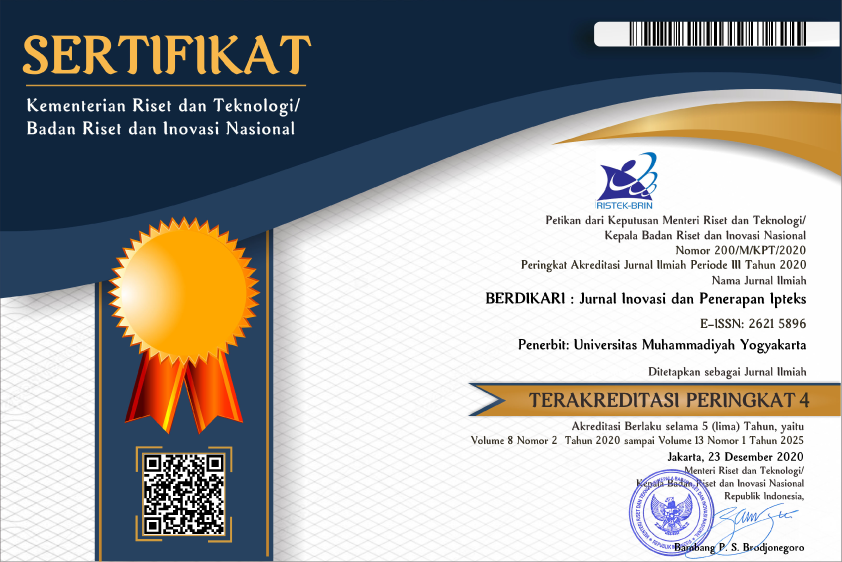Implementasi Teknik Granulasi Serbuk Jamu untuk Optimalisasi Proses Produksi Pabrik Jamu Suti Sejati
DOI:
https://doi.org/10.18196/berdikari.v10i2.13262Keywords:
brewed herbal medicine, granulation, herbal medicine, herbal medicine industryAbstract
The process of making herbal powder needs to be optimized because it is not efficient, and the filling process is still manually into teabags. The purpose of empowerment is to increase the effectiveness and efficiency of the herbal medicine-making process through a pharmaceutical approach with granulation techniques. This service is based on data obtained quantitatively in the laboratory, including the characteristics of the size distribution of Simplicia powder and granules and the flowability of herbal medicine powders. The data obtained were analyzed statistically with a 95% confidence level (p=0.05). The results showed that the granulation technique increased the flowability of the herbal powder with a flowability of 0 to 11.94±0.54 g/second. The granulation technique is able to improve the process of extracting herbs during brewing. The success of this activity is measured through the technique of increasing the flowability of herbal powders and the use of automatic teabag fillers. The results of the program showed that the granulation technique was able to increase the efficiency of the herbal powder manufacturing process at the Suti Sehati Herbal Medicine Factory, Sukoharjo.
References
Ainurofiq, A., Choiri, S., Hadi, S., Wahyuni, D. S. C., Rakhmawati, R., Handayani, N., & Nugraheni, E. R. (2020). Understanding the interaction of excipient binary mixture on pre-tableting properties. International Journal of Pharmaceutical Research, 12, 2941–2949. Scopus. https://doi.org/10.31838/ijpr/2020.SP2.349
Astana, P. R. W., & Triyono, A. (2017). Gambaran profil lipid pada pasien hipertensi di klinik saintifikasi jamu Hortus Medicus Tawangmangu. Jurnal Farmasi Galenika, 4(Edisi Khus), 63–67.
Delima, D., Widowati, L., Astuti, Y., Siswoyo, H., Gitawati, R., & Purwadianto, A. (2012). Gambaran praktik penggunaan jamu oleh dokter di enam provinsi di Indonesia. Buletin Penelitian Kesehatan, 40(3 Sep), 110-122–122. https://doi.org/10.22435/bpk.v40i3 Sep.2893.110-122
Dewi, I. K., & Lestari, T. (2016). Formulasi Dan Uji Hedonik Serbuk Jamu Instan Antioksidan Buah Naga Super Merah (Hylocereus Costaricensis) Dengan Pemanis Alami Daun Stevia (Stevia Rebaudiana Bertoni M.). Interest : Jurnal Ilmu Kesehatan, 5(2), 149–156. https://doi.org/10.37341/interest.v5i2.47
Elfahmi, Woerdenbag, H. J., & Kayser, O. (2014). Jamu: Indonesian traditional herbal medicine towards rational phytopharmacological use. Journal of Herbal Medicine, 4(2), 51–73. https://doi.org/10.1016/j.hermed.2014.01.002
Liem, A., & Rahmawati, K. D. (2017). The meaning of complementary, alternative and traditional medicine among the Indonesian psychology community: A pilot study. Journal of Integrative Medicine, 15(4), 288–294. https://doi.org/10.1016/S2095-4964(17)60336-4
Luo, L., Jiang, J., Wang, C., Fitzgerald, M., Hu, W., Zhou, Y., Zhang, H., & Chen, S. (2020). Analysis on herbal medicines utilized for treatment of COVID-19. Acta Pharmaceutica Sinica B, 10(7), 1192–1204. https://doi.org/10.1016/j.apsb.2020.05.007
Downloads
Published
Issue
Section
License
Copyright
Authors retain copyright and grant BERDIKARI Jurnal Inovasi dan Penerapan IPTEK the right of first publication with the work simultaneously licensed under an Attribution 4.0 International (CC BY 4.0) that allows others to remix, adapt and build upon the work with an acknowledgment of the work's authorship and of the initial publication in BERDIKARI Jurnal Inovasi dan Penerapan IPTEK.
Authors are permitted to copy and redistribute the journal's published version of the work (e.g., post it to an institutional repository or publish it in a book), with an acknowledgment of its initial publication in BERDIKARI Jurnal Inovasi dan Penerapan IPTEK
License
Articles published in the BERDIKARI Jurnal Inovasi dan Penerapan IPTEK) are licensed under an Attribution 4.0 International (CC BY 4.0) license. You are free to:
- Share — copy and redistribute the material in any medium or format.
- Adapt — remix, transform, and build upon the material for any purpose, even commercially.
This license is acceptable for Free Cultural Works. The licensor cannot revoke these freedoms as long as you follow the license terms. Under the following terms:
- Attribution — You must give appropriate credit, provide a link to the license, and indicate if changes were made. You may do so in any reasonable manner, but not in any way that suggests the licensor endorses you or your use.
- No additional restrictions — You may not apply legal terms or technological measures that legally restrict others from doing anything the license permits.




